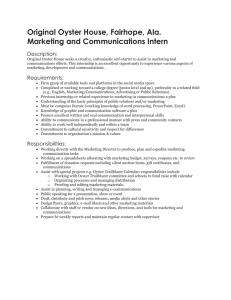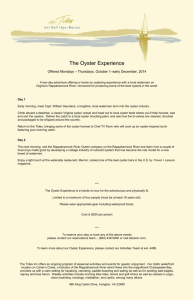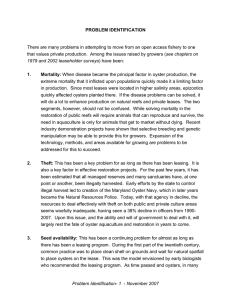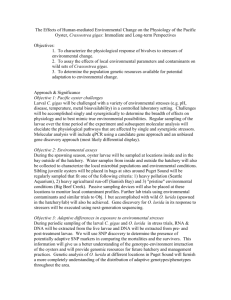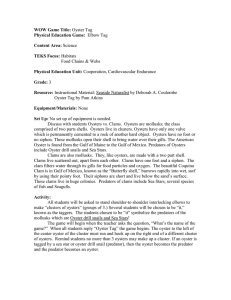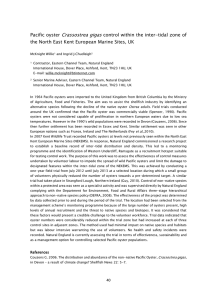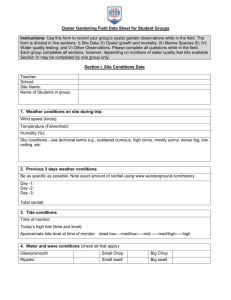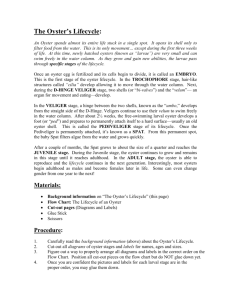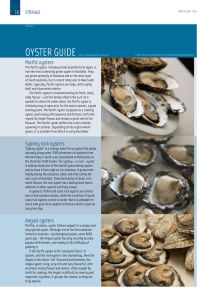Oyster Aquaculture
advertisement
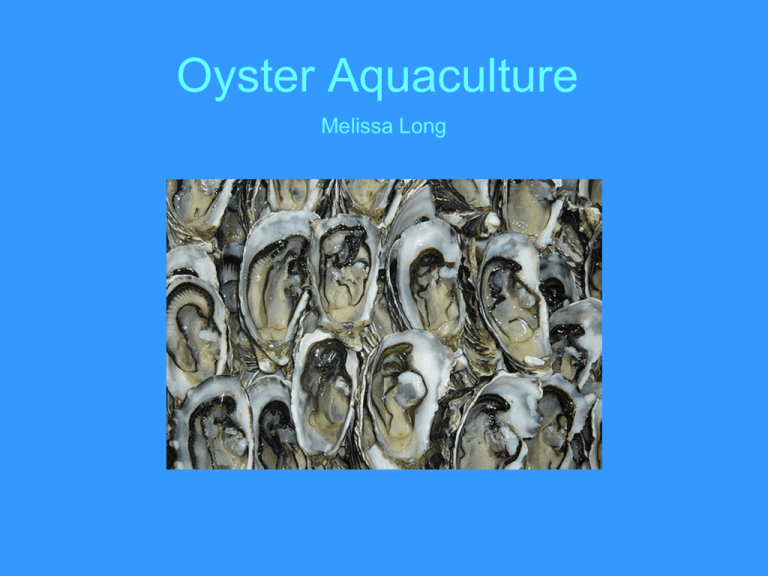
Oyster Aquaculture Melissa Long Taxonomy Eastern Oyster European Flat Oyster Crassostrea virginica Ostea edulis Pacific Oyster Crassostrea gigas Sydney Rock Oyster Saccostrea glomerata Economic Importance: Oyster aquaculture has provided a business for harvesting oysters as FOOD source for many countries Market Price: $3/ 1lb of meat Market locations: •United States •China •Korea •Japan •France Countries: •United States •China •Japan •France Life Cycle and Larval Stages • Fertilized egg develops into a: – planktonic trochophore larvae (free swimming) – Then develops into veliger larval stage (swimming) – Then develops into pediveliger larval stage (swim and crawl) • May spend about 2 weeks in larval stage before they metamorphose by settling into a “spat” • Once the oyster finds the appropriate habitat it uses cement secreted from a gland in the foot to attach permanently Reproduction in Captivity • Some oysters are protantrous hermaphrodites – Start out life as a male and most will change into a female • Oysters may be placed in separate containers for selective breeding – Eggs and sperm can be collected and distributed to the containers • Or males and females may be left together to mass fertilize • Sperm triggers females to release millions of eggs Production Methods: Hatchery: Adults: induced to spawn Larvae: fed algae until they are ready to set • Once larvae is ready to set, it is placed in upwellers that contain crushed shells Nursery: Spats are placed in nurseries to grow and harden Production Methods Growout: Where oysters can grow to maturity • Cultch set oysters are grown: – On the bottom in reefs – On ropes suspended off the bottom – Extensive culture • Single oysters are grown: – In bags that are attached to racks with several layers – Extensive culture Feeds and Feeding • Oysters feed on naturally occurring phytoplankton and detritus • No feed input Water Chemistry/ Environmental Requirements For optimal growth and induce spawning: • Water temperature: 25-30 ºC • Salinity: 10-22 ppt Advantages • Oysters clean the water, remove nitrogen, accelerate denitrification, enhance water clarity • No feed input • Nutritional value for humans: – – • Highest concentration of zinc of any food Very high in vitamin B12, iron, selenium, phosphorus, and magnesium Tastes great! Disadvantages • Fouling organisms – (such as parasites) – Compete for space and food – Restrict water movement and transportation of food • Predators – (such as crabs and oyster drills) – Must expose oyster to air to avoid predation Even though a pearl oyster is different… Resources http://www.bayoyster.com/farming.html http://www.mrc.state.va.us/Shellfish_Aquacu lture.shtm http://www.chesapeakebay.net/fieldguide/crit ter/eastern_oyster http://www.nap.edu/openbook.php?record_i d=10796&page=100
